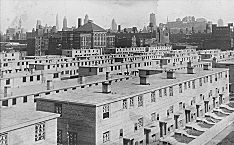| Entries |
| C |
|
Cabrini-Green
|

|
The large new apartments and large swaths of recreation space failed to mend the area's poverty. The difficulty blacks had finding better, affordable housing gave Cabrini-Green a permanent population. CHA failed to budget money to repair buildings and maintain landscaping as they deteriorated. Cabrini-Green's reputation for crime and gangs rivaled Little Hell's. The murders of two white police officers in 1970 and of seven-year-old resident Dantrell Davis in 1992 drew national attention.
Increasing real-estate values in the late twentieth century led housing officials to propose replacement of the complex with mixed-income housing. Residents argued however that such a move would displace them permanently, completing the slum removal effort begun with the building of Cabrini Homes half a century earlier.
The Encyclopedia of Chicago © 2004 The Newberry Library. All Rights Reserved. Portions are copyrighted by other institutions and individuals. Additional information on copyright and permissions.